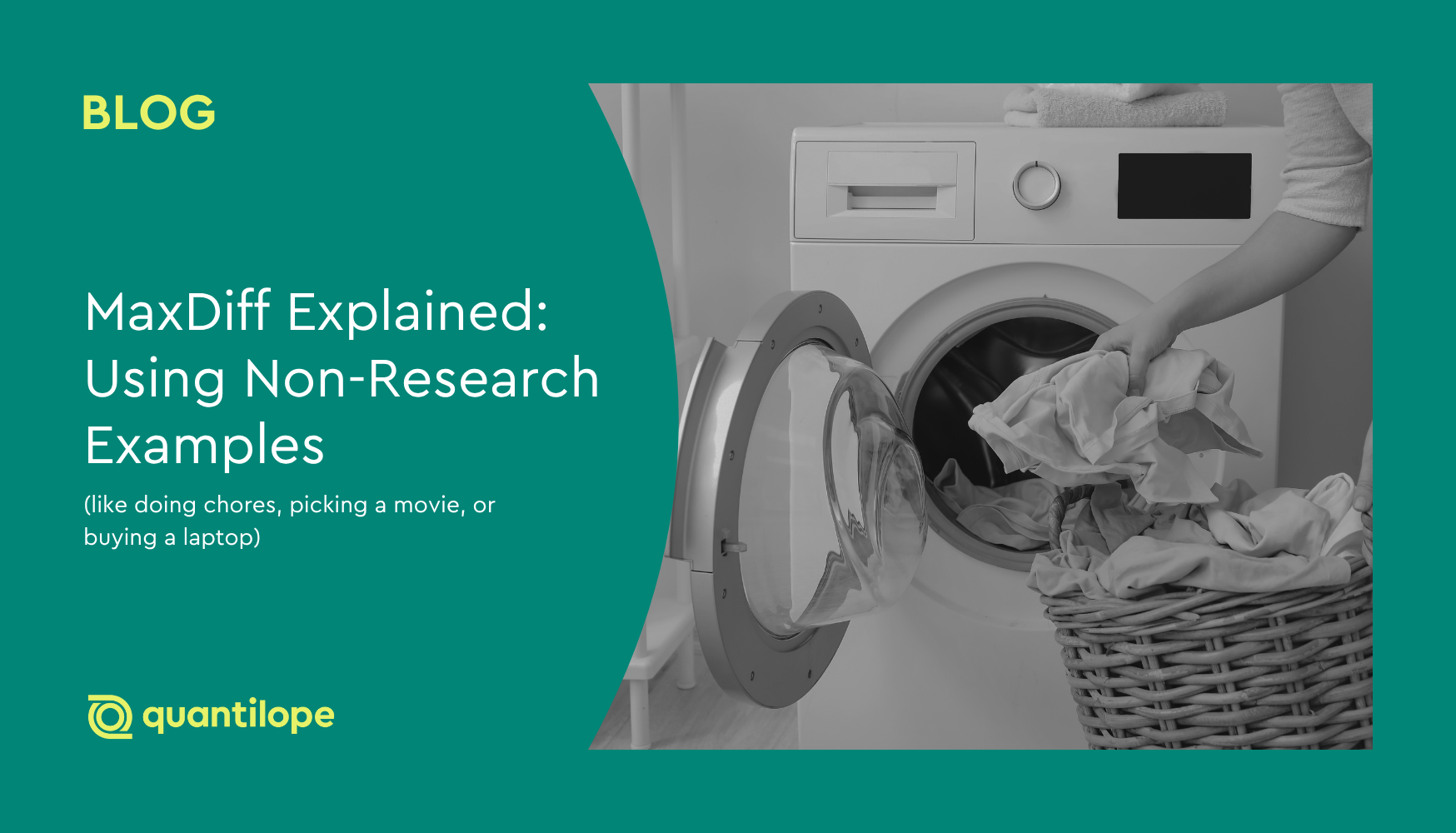A market research study is a study that brands create to understand their target audience from a variety of angles (who they are, what they do, how they act, and other behaviors relevant to their business decisions). With a variety of market research study types available, the trick is knowing which type will deliver the right kind of information.
In this blog, we look at 8 different types of market research studies and how they can tap into the specific insights needed to steer a business toward success.
Table of contents:
- Brand research studies
- Consumer insights research
- Customer satisfaction research
- Product/service research
- Competitor research
- Segmentation research
- Advertising research
- Usability testing
- Consumer research studies with quantilope
1. Brand research studies
A brand image can be a company’s greatest asset, so it’s crucial that businesses know how their brand or portfolio of brands is performing from a consumer point of view. This includes:
-
Brand awareness and recall:
Whether consumers know your brand exists, and whether they remember it (spontaneously)
-
Brand image:
How consumers perceive your brand and your brand's overall reputation
-
Brand positioning:
Your brand's values, personality, and where it sits within the competitive set
-
Brand performance:
How your brand is selling/performing in the market, and its projected future sales
-
Brand trust:
Whether your brand is viewed as reliable and if consumers trust it
-
Brand loyalty:
Whether customers stick with your brand or move on to a competitor instead
All of these brand topics can be researched using a mixture of qualitative and quantitative research, and oftentimes it would be advantageous to combine them. Aspects like brand awareness and brand loyalty are best understood via quantitative methods as solid percentages can be attached to awareness and loyalty amongst different customer segments or demographics (e.g. by life stage, location, gender). The more nuanced aspects of brand image and positioning can really be brought to life through qualitative research; hearing from consumers in their own words can clearly explain how they feel, what their body image says about the brand, and other sentiment analyses. Depending on a brand's needs, qualitative research might be used to prompt ideas for a later quantitative study, supplement insights from a previously-run quantitative study, or, used on its own.
Brands can track these metrics over a period of time using a brand health tracking approach - an equally incremented capture of consumer data to see how consumer perceptions around a brand change over time.
Back to table of contents
2. Consumer insights research
Consumer insights are all about putting together a comprehensive picture of who your target market is: their demographics, their lifestyles, their likes and dislikes, what’s important to them, their values, needs, and behaviors. It can be thought of as a ‘scene-setting’ exercise, so that brands can build consumer profiles that help guide their marketing or product development strategies. Brands might also want to run consumer insights research with regard to a certain area of its business: branding, social media activity, or product usage, for example.
Sales data can act as a starting point for consumer insights research, which brings useful knowledge around demographics. Knowing who buys your brand will determine which types of people to recruit for future market research studies. For example, if you know your customer base is made up mainly of women, you might set a sample quota that is 80% female and 20% male.
Like brand research studies, consumer insights research is beneficial both quantitatively and qualitatively. Quantitative research will provide insights in the form of numerical data while qualitative research (focus groups, interviews and observations) are useful for exploring consumers' values, needs, and behaviors in further context.
Back to table of contents
3. Customer satisfaction research
Satisfaction research investigates which areas of a brand or product are performing well and which could do with improvement. In most cases, quantitative research is used since businesses need the reliability of larger numbers to show how satisfied customers are. Survey questions ask respondents to score the brand/product/service on a variety of metrics (e.g. usability, reliability, value for money, design, taste, etc.) and computer-based analysis tools are used to calculate satisfaction according to those scores.
NPS (Net Promoter Score) is a common methodology used for this research purpose. NPS measures how likely a consumer is to recommend a product or brand to someone they know, which gives a good indication of the value they attach to it.
Back to table of contents
4. Product/service research
Product or service research forms a core part of market research in many businesses. For existing products, ensuring they remain relevant and achieve sales targets means making changes to them when appropriate. Product development research involves capturing consumer feedback on a product to identify what’s working well or where the pain points are, which feeds into ideas for improving the offer.
New product research involves presenting respondents with a concept or product mock-up/prototype and gathering feedback, while new service research means exploring the potential of a brand's service that hasn't existed before. As with many studies, qual and quant both play their part here, with qual nailing down the issues that exist and quant putting numbers against them.
Back to table of contents
5. Competitor research
Regardless of the business you’re in, knowing what/who you’re up against in your category is essential. Understanding your competitors’ strengths and weaknesses means your brand can capitalize on gaps in the market and create an option for consumers that meets their needs. This is an area where existing sales and performance data on a variety of brands can be used effectively and cheaply, as this information is generally freely available (i.e. secondary data). But primary research (new research carried out to explore the issue at hand) also has its place, with focus groups hammering out the pros and cons of various brands, and quantitative market research rating brands on relevant metrics. Once findings are in, a SWOT analysis (strengths, weaknesses, opportunities, and threats) can be created to identify what a brand should continue doing and where it should improve.
Back to table of contents
One of the best ways to understand competitors is to use a multi-implicit association test:

6. Segmentation research
Market segmentation takes a target market and divides it up into groups that share similar traits, preferences, attitudes, needs, and behaviors. It is a useful way to understand that a target market isn’t one homogenous mass of people, but that it includes different groups who operate in different ways.
This is powerful knowledge to have when developing marketing messages, as sub-groups will respond in different ways to advertising and other communications. Segmentation is primarily done through quantitative means to size the groups and quantify the prominence of traits, though segments can always be further explored through qualitative research as well.
Back to table of contents
7. Advertising research
Any business should care about whether or not its advertising is resonating with consumers in terms of message, style, and tone. Testing a selection of possible campaign routes (with an A/B test for example) helps advertising teams make the right decisions about which one to run with. Brands can test all sorts of elements in an A/B test such as advertising channel, ad format, color scheme, font size, logo placement, and so on.
As with other types of research, qual research can help in gauging initial reactions to ad executions amongst a small audience, as well as refining them once quantitative research has taken place (or, vice versa). Quantitative research delivers scores on different aspects of the advertising, thereby showing which are working well, which are irrelevant, and which require improvement.
Back to table of contents
8. Usability testing
Usability testing asks respondents to use a product or service and report on how well it performs. This could be anything from a car, to a website, to a pack of cleaning wipes. Qualitative research excels here at revealing the pertinent issues that might not have been uncovered if the research had gone straight into a quantitative approach (i.e. a consumer explaining that the scent of a cleaning wipe reminded them of a negative experience and that's why they rated it poorly).
Ethnographical research is a form of qualitative research that sheds light on how products or services are actually used, so that design teams can work on the technicalities a product. Quantitative research (whether done before, after, or apart from qualitative research) can quantifies how many consumers report good/bad usability of a product, and for what reasons.
Back to table of contents
Consumer research studies with quantilope
quantilope can help with all aspects of your research and marketing strategy. Its online qual and quant tools deliver high-quality research for all eight of the research study types outlined above and many more.
quantilope’s online survey platform makes quantitative research simple to set up, analyze, and present. With just a few clicks, you can create a questionnaire to be sent to target customers in a fraction of the time it takes with traditional research vendors. When results come in, quantilope’s automated advanced research methods take the data and model it in a way that makes the findings actionable for your business. Analysis tools like MaxDiff will identify which features of a brand or product are most important in the purchase decision, or which parts of an advertising message are most motivating. Key Driver Analysis will reveal which attributes are most likely to end in a positive outcome (customer satisfaction, loyalty, or purchase, for example.) Meanwhile, quantilope’s dedicated segmentation tool will map your target market and identify the defining characteristics and needs of each. These are just a few of quantilope’s advanced analysis methods - each created to solve specific business issues.
In addition to our quantitative offer, quantilope’s inColor video research tool takes a qualitative approach to research. Respondents post videos of themselves answering specific research questions, talking generally about a research topic, or even using a product or service. Brands can put together a sample as large or small as they wish, then use the videos to create showreels for their stakeholders that illustrate consumer views on the topics covered.
If you’d like to chat more about what quantilope's end-to-end Consumer Intelligence Platform can do for your business, get in touch below:





